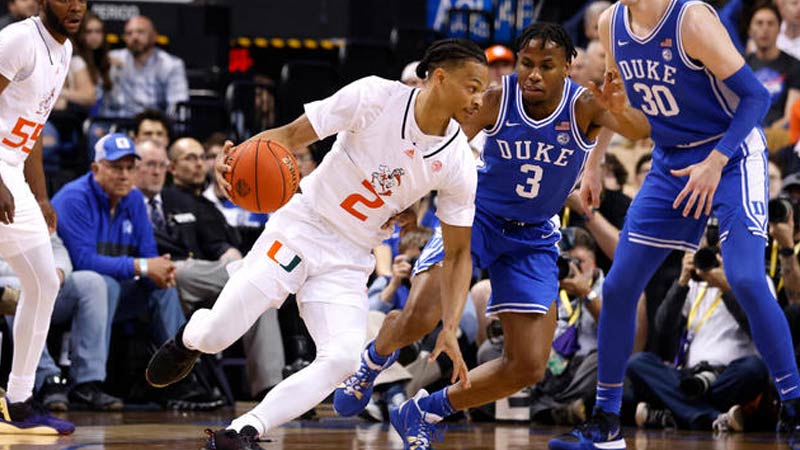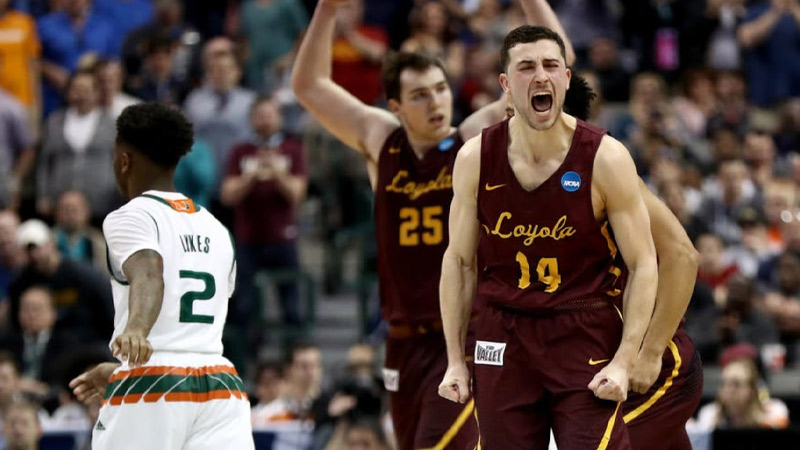March Madness is an annual basketball extravaganza that captivates sports fans and brings a thrilling surge of excitement each spring.
The NCAA Division I Men’s Basketball Tournament, lovingly known as March Madness, features 68 teams competing in a single-elimination format to determine the national champion.
With its rich history, iconic moments, and countless upsets, March Madness has become a cultural phenomenon that transcends the boundaries of the sport itself.
In this blog post, we will delve into the fascinating world of March Madness and present you with a comprehensive list of basketball facts that highlight the tournament’s significance and allure.
What Is March Madness in Basketball?
March Madness in basketball refers to the NCAA Division I Men’s Basketball Tournament, an annual event held in March and April. It is one of the most exciting and highly anticipated tournaments in sports.
March Madness features 68 college basketball teams from across the United States competing in a single-elimination format to determine the national champion.
The tournament captivates fans with its unpredictability, upsets, buzzer-beating shots, and Cinderella stories of underdog teams.
It has become a cultural phenomenon, attracting a massive audience and inspiring bracket challenges and office pools where fans predict the outcomes of the games.
March Madness showcases the best of collegiate basketball and creates an atmosphere of intense excitement and passion.
List of March Madness Basketball Facts

Source: cbsnews.com
There are tons of interesting fun facts on March Madness. Here are the 50 facts that all fans should be aware of.
- The NCAA Division I Men’s Basketball Tournament, known as March Madness, has been held annually since 1939, making it one of the longest-running sporting events in the United States.
- The tournament features 68 teams that qualify based on their regular-season performance and conference tournament results.
- The first March Madness tournament in 1939 had only eight teams competing, and the Oregon Ducks emerged as the champions by defeating the Ohio State Buckeyes.
- The tournament expanded to 64 teams in 1985, and it further expanded to the current format of 68 teams in 2011.
- Selection Sunday is the day when the tournament field is announced, with teams eagerly waiting to see if they made the cut and where they will be seeded.
- The selection committee consists of ten members who evaluate teams based on various factors such as their overall record, strength of schedule, RPI (Rating Percentage Index), and other metrics.
- The committee seeds the teams from 1 to 68 and places them in the bracket accordingly, with the top four teams in each region earning a number one seed.
- The tournament is divided into four regions: East, West, Midwest, and South. Each region has 16 teams, with the top-seeded team playing the 16th seed, the second seed playing the 15th seed, and so on.
- The first round, also known as the First Four, consists of four play-in games where eight teams compete for four spots in the main bracket.
- The tournament’s early rounds, known as the Round of 64 and Round of 32, take place over the course of the first four days, with multiple games happening simultaneously.
- Cinderella stories are a significant part of March Madness, referring to lower-seeded teams that make unexpected runs deep into the tournament. Examples include Loyola-Chicago in 2018 and George Mason in 2006.
- The Sweet Sixteen refers to the round where the remaining 16 teams compete for a spot in the Elite Eight.
- The Elite Eight consists of the eight teams that advance from the Sweet Sixteen. These games determine the teams that will move on to the Final Four.
- The Final Four is the culmination of the tournament, featuring the last four remaining teams. The games are held on a single weekend at a predetermined location.
- The championship game is played between the winners of the two Final Four games, determining the national champion.
- The tournament has produced many memorable championship games, including the 1982 showdown between North Carolina and Georgetown, famously known for Michael Jordan’s game-winning shot.
- The University of California, Los Angeles (UCLA) holds the record for the most NCAA championships, having won a total of 11 titles.
- John Wooden, the legendary coach of UCLA, won 10 championships with the team, including an unprecedented seven consecutive titles from 1967 to 1973.
- The University of Kentucky has the most tournament appearances, making it to the tournament 60 times as of 2021.
- Duke University holds the record for the number one seed, having been awarded the top seed 13 times as of 2021.
- The University of Kentucky’s “Big Blue Nation” is known for its passionate fan base, with Kentucky fans traveling in large numbers to support their team during the tournament.
- The tournament has seen several upsets over the years, where lower-seeded teams defeat higher-seeded favorites. These upsets captivate fans and create memorable moments.
- The most famous upset in March Madness history is arguably the 1983 game when the 8th-seeded Villanova Wildcats defeated the heavily favored 1st-seeded Georgetown Hoyas in the championship game.
- A 16th seed had never defeated a 1st seed until 2018 when the University of Maryland, Baltimore County (UMBC) Retrievers made history by defeating the top-seeded Virginia Cavaliers.
- The tournament’s upsets often lead to the destruction of many people’s brackets, as the unpredictability and excitement of March Madness make it challenging to accurately predict outcomes.
- The Most Outstanding Player (MOP) is awarded to the tournament’s most exceptional player, usually from the championship-winning team. Past MOP winners include Michael Jordan, Magic Johnson, and Kemba Walker.
- The tournament has seen numerous buzzer-beating shots that decide the fate of games, with Christian Laettner’s iconic shot in 1992 being one of the most memorable moments in tournament history.
- March Madness has become a cultural phenomenon, with fans across the country participating in bracket challenges and office pools where they predict the outcomes of the games and compete for prizes.
- “Bracketology” refers to the practice of predicting and analyzing tournament brackets, with experts and fans alike studying team statistics, trends, and matchups to make informed predictions.
- “One Shining Moment” is a song traditionally played at the end of the tournament, showcasing highlights and memorable moments from the tournament games.
- The tournament generates significant revenue through television rights, with broadcasting networks paying billions of dollars for the rights to air the games.
- The Final Four weekend attracts massive crowds, with fans traveling from all over the country to attend the games and experience the excitement firsthand.
- March Madness has become a platform for underdog teams to gain national recognition and exposure. A strong tournament performance can help smaller schools increase their visibility and attract talented recruits in the future.
- Some of the most successful coaches in tournament history include Mike Krzyzewski (Duke), Roy Williams (North Carolina), and John Calipari (Kentucky), who have all won multiple championships.
- The tournament’s high-stakes nature and single-elimination format create an atmosphere of intense pressure, leading to thrilling games and unexpected outcomes.
- The concept of “bracket-busting” refers to when a team or teams perform significantly better or worse than expected, causing havoc in people’s tournament brackets.
- The tournament has a significant economic impact on the host cities and regions, as fans fill hotels, restaurants, and local businesses during the games.
- The “First Four” games, which were introduced in 2011, take place in Dayton, Ohio, and serve as a play-in round for four teams competing for the final spots in the main tournament bracket.
- The phrase “March Madness” was first used in relation to college basketball by journalist Brent Musburger in the 1980s and has since become synonymous with the tournament.
- The tournament has inspired numerous books, documentaries, and films, capturing the drama and excitement of March Madness and its impact on players, coaches, and fans.
- In recent years, the use of advanced analytics and statistical models has become prevalent in predicting tournament outcomes, with data-driven approaches gaining popularity.
- Some schools have become known for their consistent success in March Madness, earning the title of “blue-blood” programs. These include Duke, North Carolina, Kentucky, and Kansas, among others.
- The tournament has a strong following among college basketball alumni, with former players and coaches actively supporting their alma maters and engaging with the tournament festivities.
- The championship game is held in different cities each year, with venues selected through a bidding process. Past championship game locations include Indianapolis, New Orleans, and San Antonio.
- In addition to the men’s tournament, there is also a Women’s NCAA Tournament, which follows a similar format and features top women’s college basketball teams competing for the national title.
- The tournament’s revenue is distributed among participating conferences, helping to fund various athletic programs and initiatives.
- The “March Madness” branding has expanded beyond basketball, with other sports and events using the term to describe their own tournament-style competitions.
- The tournament has been known to produce future NBA stars, with players like Michael Jordan, Magic Johnson, Larry Bird, and Zion Williamson showcasing their skills on the March Madness stage before moving on to successful professional careers.
- The excitement and passion surrounding March Madness extend to the fans, who often paint their faces, wear team colors, and engage in spirited chants and cheers during the games.
- March Madness has become a cultural phenomenon that brings people together, creating shared experiences, friendly rivalries, and lasting memories for college basketball enthusiasts around the world.
FAQs
What is the origin of the term “March Madness”?
The term “March Madness” was popularized by journalist Brent Musburger in the early 1980s. He used the phrase to describe the intense and unpredictable nature of the tournament, which often coincided with the month of March.
How many teams participate in March Madness?
March Madness features a total of 68 teams competing for the national championship. The selection process determines the 68 teams that are invited to the tournament based on their regular-season performance and conference tournament results.
What is the format of the tournament?
The tournament follows a single-elimination format, meaning that teams have to win each game to advance. It begins with the “First Four,” where eight teams compete for four spots in the main bracket.
The winners of the First Four join the other 60 teams in the Round of 64, and the tournament progresses through the Round of 32, Sweet Sixteen, Elite Eight, and Final Four, and ultimately culminates in the championship game.
What are some notable upsets in March Madness history?
March Madness is known for its stunning upsets, where lower-seeded teams defeat higher-seeded favorites. Memorable upsets include the 16th-seeded UMBC Retrievers defeating the 1st-seeded Virginia Cavaliers in 2018 and the 8th-seeded Villanova Wildcats overcoming the heavily favored 1st-seeded Georgetown Hoyas in the 1983 championship game.
Which team has the most NCAA championships?
The University of California, Los Angeles (UCLA) holds the record for the most NCAA championships, with a total of 11 titles. Under the coaching leadership of John Wooden, UCLA had a dominant run in the late 1960s and early 1970s, winning seven consecutive championships from 1967 to 1973.
Wrapping Up
March Madness is an extraordinary showcase of basketball talent, filled with intense competition, incredible upsets, and unforgettable moments.
The NCAA Division I Men’s Basketball Tournament has captured the hearts of sports fans worldwide, becoming an annual tradition that combines the passion of the players, the excitement of the fans, and the unpredictable nature of the game.
From the bracket-busting upsets to the heroics of future NBA stars, March Madness holds a special place in the hearts of basketball enthusiasts.
As we celebrate the tournament’s rich history and eagerly anticipate future moments of madness, let’s embrace the thrill and camaraderie that March Madness brings each year.







